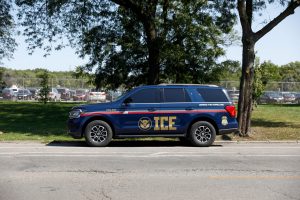Afternoon like no other for Kishwaukee Hospital handled well from planning
February 12, 2009
The afternoon of Feb. 14, 2008 seemed like any other day at Kishwaukee Community Hospital with people bringing flowers to patients and many of the departments going through shift changes.
Shortly after 3 p.m., visitors of the hospital started asking about the plethora of helicopters hovering over the otherwise quiet town of DeKalb, and it was then that the first calls started coming in.
“It was very surreal,” said Cindy Graves, director of Emergency Medical Services. “You would expect hysteria, but really everything was very controlled and actually pretty quiet [in the hospital] considering everything that was going on.”
As 18 critical patients were rushed to the hospital for treatment, the staff was prepared as they implemented the “Code Alert” disaster plan set in place specifically for situations of this magnitude.
“I personally think everything was handled very well, from the flow of the emergency department to the disposition of our patients,” said hospital administrator Brad Copple.
Even though everything ran smoothly and was well-organized, the situation provided a real test on the facilities of the new hospital, which opened four months prior to the incident.
“If this would have happened when we were in the old facility, it would not have gone nearly as well, and that has to do with just our physical space here in the emergency department,” Graves said. “We were just all so thankful that we had held out really hard for the size of our rooms and that we had thought through making sure all the rooms had the same type of set-up so we could run a trauma, a cardio, anything, in any of those rooms.”
From the moment injured students arrived at the hospital, they were treated by members of the hospital and the surrounding community both medically and emotionally. The hospital enlisted the help of social workers, counselors, volunteers and even pastors from some of the area churches to take on the difficult task of providing support to the patients and families.
“We were very grateful for the help we received from the community,” said Sharon Emanuelson, director of public relations for KishHealth System. “There were a few pastors from local churches out all day offering prayers and support to our patients.”
It was this outpouring from the community that some hospital workers said helped them make it through the day.
Some things that were most meaningful to the staff were the food and other thoughtful items from Montgomery Regional Hospital, the hospital that treated the victims of Virginia Tech, and a journal from some students which had a note of gratitude and then a place for the staff to write their feelings about the tough days.
“It meant a lot to us to have other facilities who have been through something like this reach out and say, ‘Hey, we know what you are going through, and we are thinking of you,'” Graves said of the support. “It just really brought the humanity back into it all.”
As the anniversary of the incident draws near, the members of the Kishwaukee Community Hospital reflect on the lives of those lost but also on the heroic acts of their co-workers. They take with them valuable lessons they learned during this experience and use it to move forward in the future but also to help others.
Since last year, Graves has spoken to other health care providers about what she has learned from that day.
“Three months after the incident, the ER department got a big thank-you card signed by all of the students in the classroom that day. I take that with me and say, ‘It’s not just the people you are treating that day that you are making a difference for,’ and that is why we do what we do,” Graves said.






